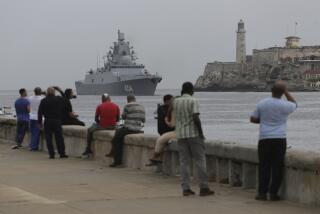Helping, Not Isolating, Cuba a Better Policy
- Share via
In a world where the United States is trading with Vietnam, considering an end to the embargo of North Korea and arranging food aid to Libya and Iran, Cuba stands like a relic of history.
The island nation and its giant neighbor seem stuck in a time warp, with the U.S. policy toward Cuba still centered on the trade embargo first imposed by President John F. Kennedy in 1962.
Yet rational experts say that life in Cuba has become too complex to simply open the door to U.S. investment. It would have the effect of extending the life of Fidel Castro’s still adamantly communist regime.
That is because Castro’s government survives today by selling the labor of its citizens to foreign investors, who pay the state hard currency to hire Cuban workers--who in turn are paid in less valuable pesos by their government.
The U.S. government wants to help the Cuban people but hesitates for fear of helping the Castro regime at the same time.
Also, the Clinton administration’s hand is stayed by implacable opposition to warming of relations with Cuba from Cuban American and right-wing political groups.
Yet conviction is growing among bipartisan U.S. foreign policy experts and many Cuban Americans that U.S. leaders need to do more, to look ahead to Cuba’s future beyond Castro.
It’s encouraging that signs of change are multiplying. Two weeks ago the Clinton administration authorized charter flights to Cuba from Los Angeles and New York, an addition to existing service from Miami. The administration is letting Cuban Americans send more money to their relatives in Cuba.
Business overtures are increasing. Thomas Donoghue, president of the U.S. Chamber of Commerce, went to Cuba in July, met with Castro, addressed university students and met with entrepreneurs and critics of the Castro regime.
David Wallace, the head of Lone Star Cement, a Stamford, Conn.-based company, is journeying in October, with the encouragement of the Cuban government. The visit will be significant because Lone Star is one of 8,500 U.S. claimants for compensation on properties expropriated in the 1960s.
Some settlement of those business claims, now totaling roughly $6 billion, will have to be made before normal commerce with Cuba can resume.
Yet nothing with the Cuban government is normal. The Castro regime insists that it is not making a transition to democracy and capitalism. The regime barely tolerates Cuban self-employment, and harasses private enterprise.
That’s why Donoghue concedes that renewing economic relations “will be a marathon, not a sprint.”
Scholars concur. “Nothing will really happen until the maximum leader departs,” says Edward Gonzalez, associate of the Rand research firm.
Yet with Cuba, the issue cannot end there. The U.S. can’t simply await the disorder, even civil war, that seems certain to erupt when Castro, now 73, dies.
Cuba is a close relative--90 miles from Florida, with more than 1 million Cuban emigres now American citizens. The two countries share a long history.
But Cuba today, long past the revolutionary romance of Castro and Che Guevara, is the poorest country in the Western Hemisphere.
With 11 million people, Cuba has $15 billion in gross domestic product--less than even the dirt-poor Dominican Republic, which has fewer people and natural resources.
Yet the Cuban people are capable of innovation and energy. When Cuba lost its Soviet subsidies in the early ‘90s, its economy shrank. In desperation, the Castro regime allowed individuals to set up self-employed businesses. And Cubans responded by opening 210,000 enterprises--restaurants in apartments and the like.
The reaction was so powerful, in fact, that it angered government agents, who cracked down on new private business and reduced the number to less than 150,000.
The regime allowed farmers to keep or sell the surplus of their crops after they had paid the state for fertilizer, fuel and capital. The result was abundance as farmers’ markets sprang up.
“Pork has been in steady supply since the markets opened in 1994, and fruits and vegetables are available too,” reports Philip Peters, an economist at Lexington Institute, an Arlington, Va., think tank.
Cuba encouraged foreign investment and is said to have attracted more than $3 billion in ventures by Canadian mining companies, Spanish hotel operators and Italian telecommunications companies.
But such investment is controversial because some foreign companies are using seized U.S. property and because it literally props up the government: The Castro regime collects hard currency from the companies while it pays their workers in pesos, using the difference in value to pay for the security police and other state apparatus. It is to avoid complicity in such a wage racket that the U.S. refuses to authorize investment in Cuba.
Yet the policy of isolating Cuba is increasingly questioned. A Council on Foreign Relations task force, headed by former Secretary of State William Rogers, recommended in a report this year that travel and contacts between the American and Cuban people be greatly increased.
The council recommended ways to get more money into the hands of ordinary Cubans, for example by allowing Cuban Americans to retire in Cuba and receive Social Security and pensions.
Despite the opposition of some Cuban Americans, many of their compatriots want restrictions eased because they know a more prosperous economy will relieve the plight of their relatives on the island.
“We should work with independent groups, of doctors, journalists, lawyers and others in Cuba,” says Daniel Fisk, a former aide to Sen. Jesse Helms. “Such groups will form the eventual succession to the Castro regime.”
It’s in everybody’s interest that the transition to post-Castro Cuba be peaceful and that the island prosper. Americans, Cubans and Cuban Americans should work to bring that about.
(BEGIN TEXT OF INFOBOX / INFOGRAPHIC)
Earning Their Bread
Almost 40 years of socialist rule have made Cuban workers among the poorest in the world. The table shows how long typical worker must toil to earn the price of a food basket, which in Cuba would cost about $2 today.
Retiree with pension: 10 days
Worker with average salary: 6 days
Emergency room doctor: 3 days
State construction worker: 2.7 days
Average self-employed worker: 1.8 days
State nickel worker: 1.5 days
Produce vendor: 1.2 days
Worker in foreign joint venture: 0.9 days
Joint venture junior manager: 0.6
*
Food basket:
1 pound rice
1 pound of pork chops
1 pound of black beans
2 pounds of tomatoes
3 limes
1 head of garlic
Sources: Philip Peters, Lexington Institute; Economist Intelligence Unit; Banco National de Cuba.
More to Read
Sign up for Essential California
The most important California stories and recommendations in your inbox every morning.
You may occasionally receive promotional content from the Los Angeles Times.










